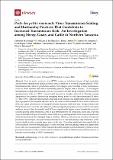| dc.description.abstract | Peste des petits ruminants virus (PPRV) causes an infectious disease of high morbidity
and mortality among sheep and goats which impacts millions of livestock keepers globally. PPRV
transmission risk varies by production system, but a deeper understanding of how transmission
scales in these systems and which husbandry practices impact risk is needed. To investigate
transmission scaling and husbandry practice-associated risk, this study combined 395 household
questionnaires with over 7115 cross-sectional serosurvey samples collected in Tanzania among
agropastoral and pastoral households managing sheep, goats, or cattle (most managed all three,
n = 284, 71.9%). Although self-reported compound-level herd size was significantly larger in pastoral
than agropastoral households, the data show no evidence that household herd force of infection
(FOI, per capita infection rate of susceptible hosts) increased with herd size. Seroprevalence and
FOI patterns observed at the sub-village level showed significant spatial variation in FOI. Univariate
analyses showed that household herd FOI was significantly higher when households reported
seasonal grazing camp attendance, cattle or goat introduction to the compound, death, sale, or giving
away of animals in the past 12 months, when cattle were grazed separately from sheep and goats, and
when the household also managed dogs or donkeys. Multivariable analyses revealed that species,
production system type, and goat or sheep introduction or seasonal grazing camp attendance, cattle
or goat death or sales, or goats given away in the past 12 months significantly increased odds of
seroconversion, whereas managing pigs or cattle attending seasonal grazing camps had significantly
lower odds of seroconversion. Further research should investigate specific husbandry practices across
production systems in other countries and in systems that include additional atypical host species to
broaden understanding of PPRV transmission. | en_US |

